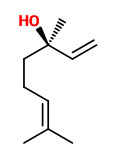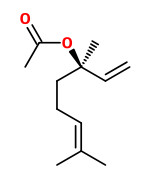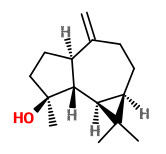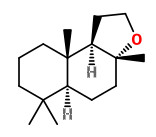Dies ist eine alte Version des Dokuments!
Salvia sclarea L. - Lamiaceae -clary sage, clary, muscatel sage, Muskateller-Salbei
Biennial or perennial herb, 0.50-1.10m high, native from South Europe to Central Asia; leaves simple, up to 30cm long, heart-shaped; flowers white to mauve or violet.
„The peculiar and highly diffusive odor signal of flowering clary-sage plants (Salvia sclarea L.) was identified to derive from trace amounts of 1-methoxyhexane-3-thiol (1) by mass-spectrometry analysis and confirmed by comparison with synthetic racemic thiol (±)-1. The enantiomers (S)- and (R)-1 were prepared by enantioselective synthesis, and the absolute configuration of (S)-1 was fully corroborated by X-ray-diffraction analysis of the crystalline thioester (1′S,1S)-2. Compound (S)-1 is one of the most powerful odorants known, with a detection threshold of 0.04⋅10−3 ng/l air, and is, with its herbaceous-green, alliaceous, and perspiration profile, key to the fragrance of clary-sage flowers and of the freshly distilled essential oil. As a consequence of its unique odor, 1 was also suspected to be part of the volatiles of a Ruta species where it was subsequently identified together with its homologue, 1-methoxyheptane-3-thiol (3), 1-methoxy-4-methylpentane-3-thiol (4), and the known 4-methoxy-2-methylbutane-2-thiol (5). The syntheses of (±)-3 and (±)-4 as well as of the enantiomer (R)-4 are described. In both natural fractions, the ratio (S)-1/(R)-1 was slightly in favor of the (S)-enantiomer. Natural 4 has (R)-configuration.“
[1‐Methoxyhexane‐3‐thiol, a Powerful Odorant of Clary Sage (Salvia sclarea L.). van de Waal, M., Niclass, Y., Snowden, R. L., Bernardinelli, G., Escher, S., Helvetica chimica acta, Vol.85(5), 2002, 1246-1260]
„The analysis of the volatile components in the essential oil of Salvia sclarea L. (Labiatae) by GC and GC-MS demonstrated the presence of at least 72 compounds. They correspond to 97.2% of the oil. The major compounds were linalool, linalyl acetate, terpineol, neryl acetate, geraniol, geranyl acetate, nerol, and sclareol.“
[Constituents of the essential oil of Salvia sclarea growing wild in Greece. Souleles, C., Argyriadou, N. , Pharmaceutical Biology, Vol.35(3), 1997, 218-220]
(The diterpene sclareol is a valued starting material for semisynthesis of Ambrox® and related ambergris substitutes.)
Major constituents of the essential oil of fresh inflorescences were linalyl acetate (39.6%), linalool (28.8%), α-terpineol (5.6%), sclareol (2.4%), geraniol (2.1%), geranyl acetate (2.3%), (E)-β-ocimene (2.5%), myrcene (1.7%), neryl acetate (1.1%) and limonene (1.0%). Mminor constituents were e.g. camphor (0.1%), (Z)-linalool oxide (0.1%) and terpinen-4-ol (0.6%).
[Verma, Ram Swaroop, et al. „Aroma Profile of Clary Sage (Salvia sclarea L.): Influence of Harvesting Stage and Post Harvest Storage in Uttarakhand Hills.“ Medicinal and Aromatic Plant Science and Biotechnology 5.2 (2011): 139-142] http://www.globalsciencebooks.info/Online/GSBOnline/images/2011/MAPSB_5(2)/MAPSB_5(2)139-142o.pdf
„… the essential oil of S. sclarea L. is dominated by two monoterpenes, linalool and linalylacetate, which mostly determine the oil quality in all the tested phases of development; they constitute 86.07% from total oil mass.“
[Investigation on the essential oil of cultivated Salvia sclarea L., Pešić, P. Ž., Banković, V. M., Flavour and fragrance journal, Vol.18(3), 2003, 228-230]
Analysis of a commercial sample from serbia showed that the main components of the essential oil were linalyl acetate (52.83%), linalool (18.18%), α-terpineol (5%), α-pinene (4.57%), 1.8-cineole (2.29%), limonene (1.55%), β-caryophyllene (1.83%) and β-terpineol (1.19%).
[Chemical composition and antifungal activity of Salvia sclarea (Lamiaceae) essential oil. Džamić, A., Soković, M., Ristić, M., Grujić-Jovanović, S., Vukojević, J., Marin, P. D., Archives of Biological Sciences, Vol.60(2), 2008, 233-237]
http://www.doiserbia.nb.rs/img/doi/0354-4664/2008/0354-46640802233D.pdf
Of the ca. 250 constituents identified in clary sage oil, (R)-linalyl acetate (67%) and (R)-linalool (16%) represent the main part of the oil, but the odor of the oil is based on trace compounds. Some cyclic ethers (pyranes) possess camphoraceous odors. Sesquiterpene derivatives play an important role: (3R,6E)-3,15-epoxy-caryophyll-6-ene (woody), β-caryophyllene oxide (woody), (+)-spathulenol (aromatic earthy), (+)-isospathulenol (aromatic earthy), 1,5-epoxy-salvial-(4,14)-ene (spicy floral, stronger than its thia analog mint sulfide), α-bisabolol (floral), 10-epi-ɣ-eudesmol (woody), salvial-4(14)-ene-1-one (woody), (-)-ambrox (ambergris), and ɣ-bicyclohomofarnesal (ambergris). The labdanoid diterpenediol (-)-sclareol (2% in clary sage oil, 70% in its absolute) is isolated from oil or absolute on industrial scale as starting material for the synthesis of (-)-ambrox.
[Scent and Chemistry, Günther Ohloff, Wilhelm Pickenhagen, Philip Kraft, Wiley-VCH, 2012, 247-250]
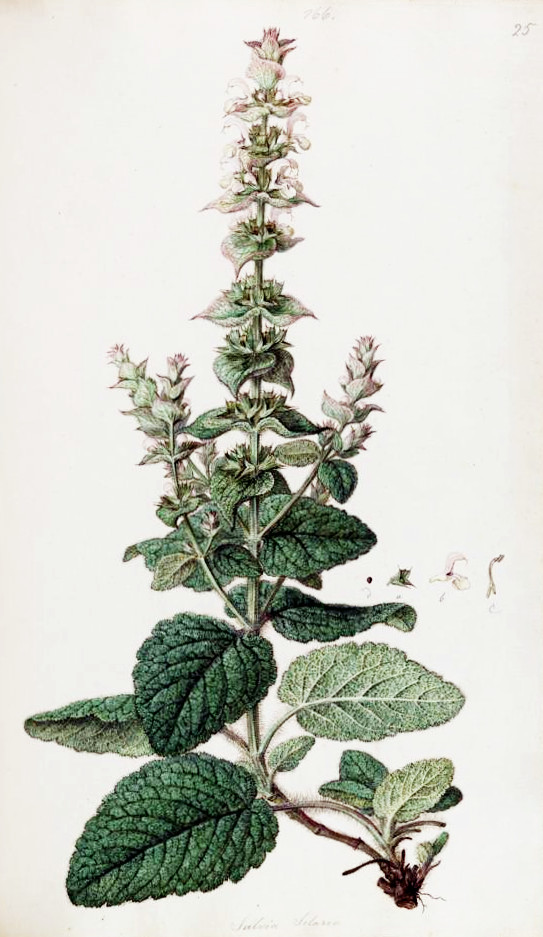
Sibthrop, J., Smith, J.E., Flora Graeca (drawings), vol.1, t.25 (1806)
http://plantgenera.org/species.php?id_species=903766
Salvia sclarea
© Rolf Marschner (2006),
www.botanische-spaziergaenge.at


